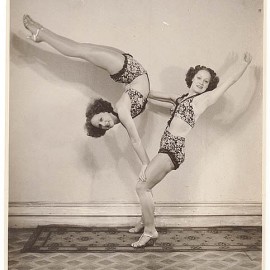Falls and fall prevention have been in the news lately and for good reason. Baby-boomers are hitting retirement in droves and falls are still a major cause of hospitilization and death in the 65+ population. A recent New York Times article caught my attention becaues it touched on a subject that was also a feature of the last book I read and wrote about (Thinking, Fast and Slow). In Wichita, Kansas a program called Standing Strong is tackling the falling problem by training both muscles as well as cognition. This is worth thinking about.
An example of the Standing Strong program is having participants stand on a 3 inch foam pad while focusing on sets of words. The letters spell out colors such as yellow or blue. Soon though, the actual letters that make up the word are changed from balck type to colored type. Now the word blue will be presented in yellow type. The participants are then asked to look at the word and say the color they see, not what the word spells – all while balancing of course!
The book Thinking, Fast and Slow tells about what is going on here. The brain, according to the book, has two opperating systems. System 1 is a subconcious one, allowing you to automatically navigate through much of your daily routine without having to pay much active attention. System 2 is the slower, more deliberate system that is employed in more complicated situations. Reading the words yellow or blue written in black type would be simple and intuitive, a system 1 task. However, when the color of the letters is different than the color the word spells, System 2 is required. You need to stop and mentally check your answer before speaking, and this takes attention and mental energy. (1)
A really great example of the implications of this for physical activity is the ‘stopping-in-your-tracks’ phenomenon. We all have experienced walking along with a person telling a story. We are walking along talking when suddenly we get to some detail we are unsure of, like the exact date of the vacation we are discussing. As soon as you realize your uncertainty and you need to stop to do some mental checking what happens? You stop in your tracks. This is an interesting example of the interplay between the two systems. Once system 2 starts working hard it is as if we don’t have enough capacity left to keep moving our feet under us. We need to shut something off for a moment in order to harness the necessary brain power. (2)
That brings us back to the NYTimes article. The Doctor is trying to improve the participants ability to maintain balance, a system 1 function, while performing a system 2 operation. The hope is that the trainees will become better at staying balanced evein if they are distracted and that that will help to reduce falls. What do you think about that, personal trainers?
For me, what immediately comes to mind is the specificty principle. Specificity is the idea that in order to become better at something, you must practice that thing. To be a better cyclist you must cycle, better runner you must run, better basketball player play basketball, and so on. There are certainly some crossover skills, like having a strong squat and deadlift, but swimming is not likely to make you a better three point shooter. I wonder how this principle might apply to the Standing Strong program. Will standing on a foam pad while reciting colors help you get your foot up over the curb while a car is honking at you to get out of the way?
The article and the Doctor, to their credit, acknowledge that they do not have the answer to this question both because they do not have much long term data and also, because getting the right data will be tricky. How do you separate out the effect of practicing standing on a pad versus standing on a pad and reciting colors? It is no easy task.
I for one will wait to see what evidence can be conclusively compiled before spending much time distracting clients on a foam pad. I have found until now that most peoples strength and flexibility deficits are more than enough to focus on when attempting to improve their ability to safely move around. As long as we remain as a society so glaringly sedentary and de-conditioned, I’d rather go with something I know we need. What do you think?
Related Article: Tunnel Vision in the Gym and WYSIATI
(1) Kahneman, Daniel. Thinking, Fast and Slow. New York, NY; Farrar, Straus and Giroux, 2011
(2) Ibid.
Training the Mind to Ward Off Falls – http://www.nytimes.com/2015/03/12/business/retirementspecial/training-the-mind-to-ward-off-falls.html?_r=0

Pingback: Treadmill Desks And Doughnut Hamburgers - do the movement June 13, 2015
[…] this. As Daniel Kahneman tells us in his book Thinking, Fast and Slow (which is featured in this post) we only have so much brainpower and every task we undertake utilizes some. Thus, the more tasks we […]